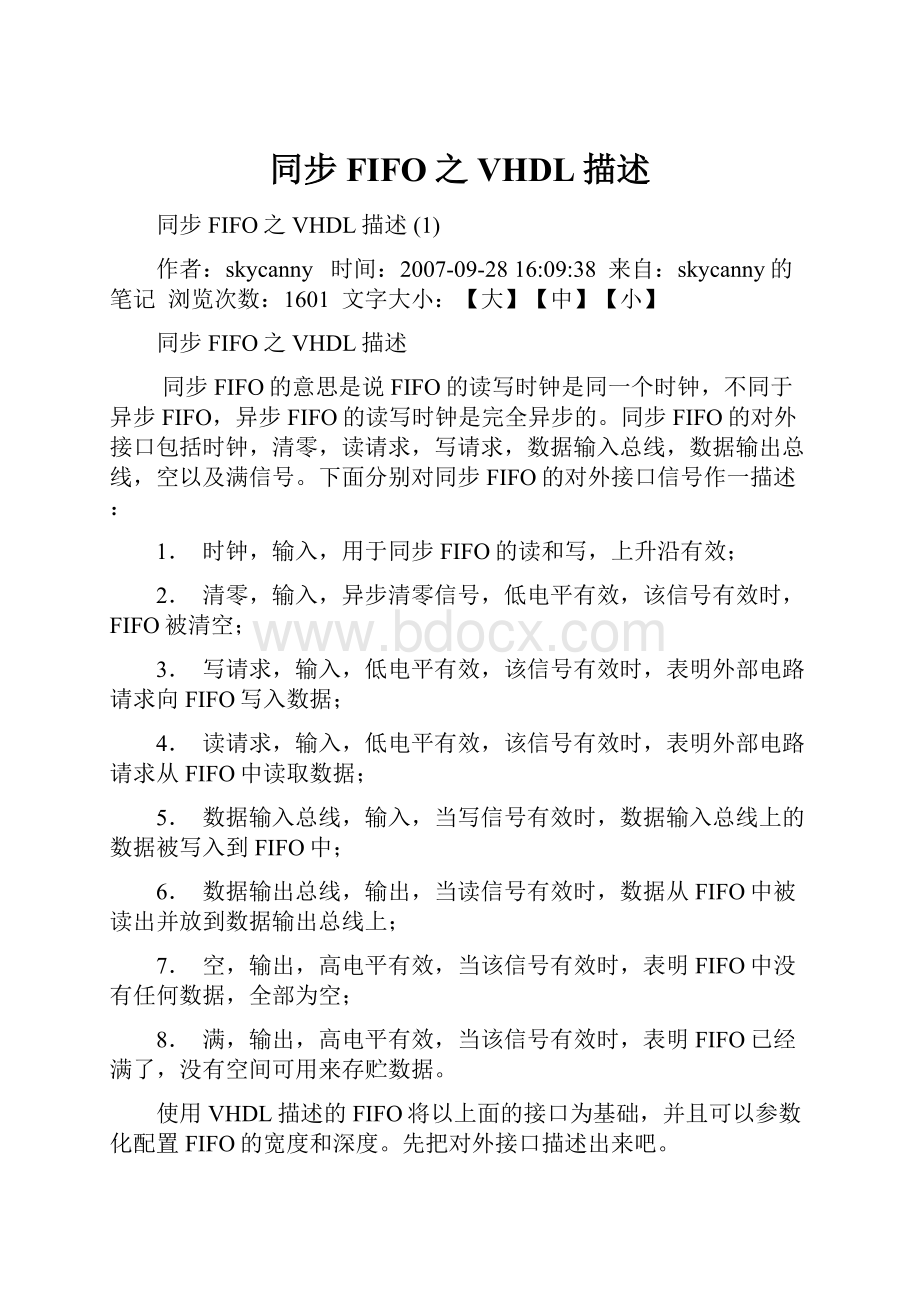 同步FIFO之VHDL描述.docx
同步FIFO之VHDL描述.docx
- 文档编号:25455685
- 上传时间:2023-06-08
- 格式:DOCX
- 页数:22
- 大小:76.98KB
同步FIFO之VHDL描述.docx
《同步FIFO之VHDL描述.docx》由会员分享,可在线阅读,更多相关《同步FIFO之VHDL描述.docx(22页珍藏版)》请在冰豆网上搜索。

同步FIFO之VHDL描述
同步FIFO之VHDL描述
(1)
作者:
skycanny 时间:
2007-09-2816:
09:
38 来自:
skycanny的笔记 浏览次数:
1601 文字大小:
【大】【中】【小】
同步FIFO之VHDL描述
同步FIFO的意思是说FIFO的读写时钟是同一个时钟,不同于异步FIFO,异步FIFO的读写时钟是完全异步的。
同步FIFO的对外接口包括时钟,清零,读请求,写请求,数据输入总线,数据输出总线,空以及满信号。
下面分别对同步FIFO的对外接口信号作一描述:
1. 时钟,输入,用于同步FIFO的读和写,上升沿有效;
2. 清零,输入,异步清零信号,低电平有效,该信号有效时,FIFO被清空;
3. 写请求,输入,低电平有效,该信号有效时,表明外部电路请求向FIFO写入数据;
4. 读请求,输入,低电平有效,该信号有效时,表明外部电路请求从FIFO中读取数据;
5. 数据输入总线,输入,当写信号有效时,数据输入总线上的数据被写入到FIFO中;
6. 数据输出总线,输出,当读信号有效时,数据从FIFO中被读出并放到数据输出总线上;
7. 空,输出,高电平有效,当该信号有效时,表明FIFO中没有任何数据,全部为空;
8. 满,输出,高电平有效,当该信号有效时,表明FIFO已经满了,没有空间可用来存贮数据。
使用VHDL描述的FIFO将以上面的接口为基础,并且可以参数化配置FIFO的宽度和深度。
先把对外接口描述出来吧。
---------------------------------------------------------------------------------------------------------
--Designer:
skycanny
--Date:
2007-1-29
--Description:
SynchronousFIFOcreatedbyVHDL
libraryieee;
useieee.std_logic_1164.all;
useieee.std_logic_unsigned.all;
useieee.std_logic_arith.all;
entitysfifois
generic(width:
positive
depth:
positive
);
port
(
clk:
instd_logic;
rst:
instd_logic;
wq:
instd_logic;
rq:
instd_logic;
data :
instd_logic_vector(width-1downto0);
q:
instd_logic_vector(width-1downto0);
empty:
outstd_logic;
full:
outstd_logic
);
endentitysfifo;
-----------------------------------------------------------------------------------------------------------
同步FIFO内部通过控制电路和RAM实现,控制电路主要包括写指针管理电路,读指针管理电路,以及FIFO状态判断电路,对于同步FIFO来讲,读和写的指针管理电路实际上就是二进制计数器。
现在的FPGA都具有BlockRAM,通过VHDL描述可以对其进行调用,为了能够实现任意深度和宽度的FIFO,那么在用VHDL描述RAM的时候需要使用generic使得RAM的调用能够参书化。
同样,对于读写指针计数器,也需要参数化的描述方法。
下面主要对FIFO的状态判断如何判断进行一些说明。
假设宽度任意而深度为8的FIFO,当读指针read_pointer和写指针write_pointer的值一样的时候,很显然,这时FIFO的状态为空。
比较麻烦的是对FIFO是否已经满的状态的判断,因为存在两种情况,第一种情况时写指针write_pointer比读指针read_pointer大,比如writer_pointer=7而read_pointer=0,还有一种情况时写指针writer_pointer比读指针read_pointer小,比如writer_pointer=2而read_pointer=3。
由于读写电路在循环的读写RAM,所以在上面的两种情况下FIFO实际上都已经满了。
那么如何对读写指针的判断比较容易的得出FIFO已经满了,同时这样的判断电路还要容易参数化?
第一种情况下,write_pointer–read_pointer=7,实际上就是FIFO深度减一,第二种情况下,(write_pointer+8)–read_pointer=7,也是FIFO深度减一。
从上面的讨论就可以很容易进行判断FIFO状态了,假设FIFO的深度用depth表示,则FIFO状态判断用伪码表示如下:
1. Empty状态判断:
Ifwriter_pointer=read_pointer
FIFOisempty;
Else
FIFOisnotempty;
Endif;
2.Full状态判断:
Ifwriter_pointer>read_pointer
Ifwrite_pointer–read_pointer=depth
FIFOisfull;
Else
FIFOisnotfull;
Endif;
Else
Ifwrite_pointer–read_pointer=1
FIFOisfull;
Else
FIFOisnotfull;
Endif;
Endif;
下面的框图主要描述同步FIFO的内部结构,画出框图有助于对电路结构的理解,同样也有助于RTL代码的编写
今天就先写到这里吧,大家有什么问题和意见可以提出来,以便我及早的发现问题,不要等到要写代码的的时候才发现就麻烦了。
今天又重新安装了UltraEdit,QuartusII6.0和ModelsimSE6.0,这次安装以后系统没有发现什么异常。
另外还安装了紫光的拼音输入法,用习惯了这个,微软呀,智能ABC这些都用不太习惯。
最后把系统备份了一下,以免将来出了什么问题还可以还原一下,呵呵。
还是接着昨天的《同步FIFO之VHDL描述》。
突然发现用于实现FIFO的RAM必须是真正意义上的双口RAM,也就是读写可以同时进行的,以前只是用VHDL描述过单端口的RAM,双口RAM还没有描述过,不过曾经看到过XilinxFPGA/CPLD的开发工具ISE的CoreGenertor好像提供双口RAM的软核,所以我想用HDL语言也就应该可以描述从而调用双口RAM,这个等到具体写双口RAM的RTL代码的时候再研究。
还有一个问题就是FIFO的读写请求控制信号必须要控制FIFO读写指针的产生电路,只有读写信号信号有效的时候,FIFO读写指针才能是有效的,负责是无效而且要保持不变,这个容易理解。
今天,就先完成写指针产生和管理电路的RTL代码吧,其实很简单,就是一个二进制计数器。
下面就是VHDL的代码,大家看看有没有什么问题。
-----------------------------------------------------------------------------------------------------------
--Designer:
skycanny
--Date:
2007-2-2
--Description:
write_pointeriscreated
--Modification:
addFIFOstatusfulljudge2007-2-3skycanny
libraryieee;
useieee.std_logic_1164.all;
useieee.std_logic_unsigned.all;
useieee.std_logic_arith.all;
entitywrite_pointeris
generic
不明白写/读指针为什么是“depth-1downto0”位的矢量,depth不是FIFO的深度吗?
难道深度16的FIFO的写/读指针为std_logic_vector(15downto0)类型吗?
(
depth:
positive
);
port
(
clk:
instd_logic;
rst:
instd_logic;
wq:
instd_logic;
full:
instd_logic;
wr_pt:
outstd_logic_vector(depth-1downto0)
);
endentity;
architectureRTLofwrite_pointeris
signalwr_pt_t:
std_logic_vector(depth-1downto0);--writerpointercounter
begin
process(rst,clk)
begin
ifrst='0'then
wr_pt_t<=(others=>'0');
elsifclk'eventandclk='1'then
ifwq='0'andfull='0'then
wr_pt_t<=wr_pt_t+1;
endif;
endprocess;
wr_pt<=wr_pt_t;
endRTL;
同步FIFO之VHDL描述
(2)
作者:
skycanny 时间:
2007-09-2816:
09:
38 来自:
skycanny的笔记 浏览次数:
1602 文字大小:
【大】【中】【小】
今天准备完成同步FIFO其他模块的代码,主要包括读指针管理和产生电路,FIFO状态判断电路,以及双端口RAM的VHDL描述。
先是读指针管理和产生电路:
-----------------------------------------------------------------------------------------------------------
--Designer :
skycanny
--Date :
2007-2-3
--Description :
read_pointeriscreated
libraryieee;
useieee.std_logic_1164.all;
useieee.std_logic_unsigned.all;
useieee.std_logic_arith.all;
entityread_pointeris
generic
(depth :
positive
);
port
(clk :
in std_logic;
rst :
in std_logic;
rq :
in std_logic;
empty :
in std_logic;
rd_pt :
out std_logic_vector(depth-1downto0)
);
endentityread_pointer;
architectureRTLofread_pointeris
signal rd_pt_t :
std_logic_vector(depth-1downto0); --readpointercounter
begin
process(rst,clk)
begin
ifrst='0'then
rd_pt_t<=(others=>'0');
elsifclk'eventandclk='1'then
ifrq='0'andempty='0'then
rd_pt_t<=rd_pt_t+1;
endif;
endprocess;
rd_pt<=rd_pt_t;
endRTL;
------------------------------------------------------------------------------------------------------------
刚才想了一下,读写指针产生电路必须要对FIFO的状态进行判断,所以又对上面的代码进行了一点修改(上面的代码是修改过的),判断FIFO的状态,这一点在刚开始的时候给疏忽了,幸好刚才给发现了。
同样昨天写的写指针产生电路没有判断FIFO的full状态,也要进行修改,还是在昨天的基础上修改吧,就不在这里罗嗦了,下面就是FIFO状态判断电路的VHDL描述。
-----------------------------------------------------------------------------------------------------------
--Designer:
skycanny
--Date:
2007-2-3
--Description:
read_pointeriscreated
libraryieee;
useieee.std_logic_1164.all;
useieee.std_logic_unsigned.all;
useieee.std_logic_arith.all;
entityjudge_statusis
generic
(
depth:
positive
);
port
(
clk:
instd_logic;
rst:
instd_logic;
wr_pt:
instd_logic_vector(depth-1downto0);
rd_pt:
instd_logic_vector(depth-1downto0);
empty:
outstd_logic;
full:
outstd_logic
);
endentityjudge_status;
architectureRTLofjudge_statusis
begin
process(rst,clk)
begin
ifrst='0then
empty<='1';
elsifclk'eventandclk='1'then
ifwr_pt=rd_ptthen
empty<='1';
else
empty<='0';
endif;
endif;
endprocess;
process(rst,clk)
begin
ifrst='0'then
full<='0';
elsifclk'eventandclk='1'then
ifwr_pt>rd_ptthen
if(rd_pt+depth)=wr_ptthen
full<='1';
else
full<='0';
endif;
else
if(wr_pt+1)=rd_ptthen
full<='1';
else
full<='0';
endif;
endif;
endif;
endprocess;
endRTL;
-----------------------------------------------------------------------------------------------------------
广告时间欢迎访问skycanny的笔记(副站)。
现在就开始双口RAM的VHDL描述吧,这个可是很重要的。
下面的代码在Altera的CycloneII系列的器件上通过了后仿真。
-----------------------------------------------------------------------------------------------------------
--Designer:
skycanny
--Date:
2007-2-3
--Description:
ThisVHDLfileisdesignedtogenerateadualportram
--Device:
CycloneII
libraryieee;
useieee.std_logic_1164.all;
useieee.std_logic_unsigned.all;
useieee.std_logic_arith.all;
entitydualramis
generic
(
width:
positive:
=16;
depth:
positive:
=8
);
port
(
-------------------------portaisonlyforwriting-------------------------------
clka:
instd_logic;
wr:
instd_logic;
addra:
instd_logic_vector(depth-1downto0);
datain:
instd_logic_vector(width-1downto0);
------------------------------------------------------------------------------------
-------------------------portbisonlyforreading-------------------------------
clkb:
instd_logic;
rd:
instd_logic;
addrb:
instd_logic_vector(depth-1downto0);
dataout:
outstd_logic_vector(width-1downto0)
------------------------------------------------------------------------------------
);
endentitydualram;
architectureBehavioralofdualramis
typeramisarray(2**depth-1downto0)ofstd_logic_vector(width-1downto0);
signaldualram:
ram;
begin
process(clka,clkb)
begin
ifclka'eventandclka='1'then
ifwr='0'then
dualram(conv_integer(addra))<=datain;
endif;
endif;
endprocess;
process(clkb)
begin
ifclkb'eventandclkb='1'then
ifrd='0'then
dataout<=dualram(conv_integer(addrb));
endif;
endif;
endprocess;
endBehavioral;
-----------------------------------------------------------------------------------------------------------
抓个后仿真的图形吧,需要testbench的投票留言。
另外今天还发现前仿真的时候可以用generic传递参数,而后仿真的时候就不能用generic传递参数了,Modelsim会报错“Nodefaultbindingforcomponentat”。
后来想了一下确实应该是这样的,因为后仿真的时候电路都已经布局布线完成了,还有什么参数需要generic传递呀?
昨天晚上把所有的模块描述都完成了,同时还完成了双端口RAM的后仿真,从目前的仿真结果来看,应该没有什么问题。
今天的任务就是把这些模块组装起来并完成前后仿真,这样同步FIFO的VHDL描述就算全部完成了。
按照前面的思路和框图,把这些模块组装起来应该很简单,下面就直接给出VHDL代码。
当然组装的过程还要排查除了双口RAM以外电路的代码描述有没有问题,如果有问题的话就就地改正了,呵呵。
在代码的集成和仿真的时候还真发现了一些问题,主要包括数据的寄存,以及空满状态判断上,最后的代码使用QuartusII6.0综合和布局布线,选用的是CycloneII系列的器件,并用Modelsim进行了功能仿真和时序仿真,两种仿真均通过。
下面主要是集成的定层文件和时序仿真图(图1,图2,图3,图4,图5)。
---------------------------------------------------------------------------------------------------------
--Designer:
skycanny
--Date:
2007-2-4
--Description:
SynchronousFIFOcreatedbyVHDL
libraryieee;
useieee.std_logic_1164.all;
useieee.std_logic_unsigned.all;
useieee.std_logic_arith.all;
entitysfifois
generic
(
width:
positive:
=16;
depth:
positive:
=8
);
port
(
clk:
instd_logic;
rst:
instd
- 配套讲稿:
如PPT文件的首页显示word图标,表示该PPT已包含配套word讲稿。双击word图标可打开word文档。
- 特殊限制:
部分文档作品中含有的国旗、国徽等图片,仅作为作品整体效果示例展示,禁止商用。设计者仅对作品中独创性部分享有著作权。
- 关 键 词:
- 同步 FIFO VHDL 描述
 冰豆网所有资源均是用户自行上传分享,仅供网友学习交流,未经上传用户书面授权,请勿作他用。
冰豆网所有资源均是用户自行上传分享,仅供网友学习交流,未经上传用户书面授权,请勿作他用。


 《初级会计实务》试题题库大全及答案详解.docx
《初级会计实务》试题题库大全及答案详解.docx
